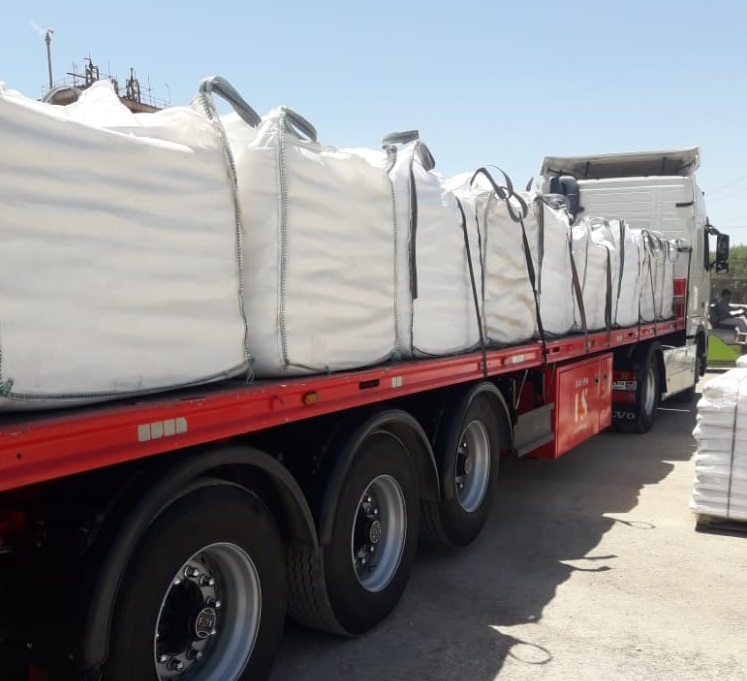Supplier of Caustic Soda Flakes from Turkey & UAE

Caustic Soda Flakes (NaOH) Overview
If you work in manufacturing, from producing everyday soap to treating our water supply, you’ve likely encountered Caustic Soda Flakes. Known scientifically as sodium hydroxide (NaOH), these white, crystalline flakes are a cornerstone of modern industry. But what exactly makes them so indispensable?
In simple terms, Caustic Soda Flakes are a highly versatile and powerful alkaline chemical. They dissolve instantly in water, releasing heat and creating a potent solution perfect for cleaning, breaking down organic matter, and driving countless chemical reactions. Whether you’re a plant manager sourcing raw materials or a chemist developing new products, understanding this compound is key to both efficiency and safety.
Physical and Chemical Properties of Caustic Soda Flakes
A clear understanding of caustic soda flakes’ properties is essential for safe handling and effective industrial use:
-
Chemical Formula: NaOH
-
Molar Mass: 40.00 g/mol
-
Appearance: White, flat crystalline flakes
-
Odor: Odorless
-
Density: 2.13 g/cm³ (solid)
-
Melting Point: 318°C
-
Boiling Point: Decomposes before boiling
-
Solubility: Highly soluble in water (up to 1,000 g/L at 20°C); releases heat upon dissolution
-
Alkalinity (pH): 12–14
-
Reactivity: Reacts strongly with acids, certain metals (e.g., aluminum), and moisture; generates exothermic reactions with water
-
Corrosiveness: Highly corrosive to skin, metals, and organic materials
These properties make NaOH flakes an essential base chemical for pH regulation, neutralization, and synthesis across multiple industries.
How Are NaOH Flakes Made? The Chlor-Alkali Process
The journey to high-purity Caustic Soda Flakes begins with common salt. Most global production relies on the efficient chlor-alkali process:
-
Electrolysis: A concentrated brine solution (Sodium Chloride, NaCl) is electrified, splitting it into sodium hydroxide, chlorine gas, and hydrogen gas.
-
Concentration & Purification: The resulting caustic soda solution is evaporated and purified to remove impurities.
-
Flake Formation: The concentrated liquid is cooled and solidified, then scraped to form the familiar thin, white caustic soda flakes we know.
-
Packaging: Finally, the flakes are dried and packaged in moisture-proof bags to ensure stability and ease of shipping.
Grades of Caustic Soda Flakes
Caustic soda flakes are available in multiple grades to match specific industrial needs:
| Grade | Purity | Key Uses | Applications |
|---|---|---|---|
| Technical Grade | 96–98% | pH adjustment, metal cleaning, textile processing | General industrial tasks like soap production or water softening |
| Industrial Grade | 98–99% | Oil refining, alumina extraction, pulp bleaching | Heavy-duty petrochemical, mining, and manufacturing operations |
| Food Grade | ≥99% | Fruit and vegetable peeling, cocoa processing, olive curing | FDA-approved applications in food and beverage processing |
| Pharmaceutical Grade | ≥99.5% | Drug synthesis, cosmetics | Healthcare and personal care products |
| Reagent Grade | ≥99.5% | Laboratory analysis, chemical research | Precision analytical chemistry and R&D labs |
Where Are Caustic Soda Flakes Used?
The true measure of an industrial chemical’s importance is its footprint across diverse sectors. Caustic Soda Flakes are not a niche product; they are a fundamental pillar supporting everything from heavy industry to the food on our tables. Their powerful reactivity as a strong alkali and a key nucleophile makes them indispensable in countless processes. Let’s explore the critical applications that make sodium hydroxide a global workhorse.
Soap and Detergent Manufacturing
This is one of the oldest and most essential uses of Caustic Soda Flakes. The process, known as saponification, is a classic chemical reaction where NaOH reacts with fats and triglycerides. This reaction breaks down the fat molecules, forming soap (a fatty acid salt) and glycerol. Without this crucial step, the production of bar soaps, laundry detergents, and other cleaning agents would be impossible. The high purity of the flakes ensures a consistent and high-quality final product.
Water and Wastewater Treatment
In municipal and industrial water treatment plants, Caustic Soda Flakes play a dual role:
-
pH Adjustment and Neutralization: Industrial effluents and acidic raw water can be highly corrosive to piping and harmful to the environment. NaOH is the preferred choice for efficiently raising the pH, neutralizing acidic contaminants, and bringing water into a safe, neutral range.
-
Heavy Metal Removal: By increasing the pH, caustic soda causes dissolved heavy metals like lead, copper, and cadmium to become insoluble, precipitating them out of the water so they can be filtered and removed safely.
The Alchemical Heart of Chemical Production
Caustic Soda Flakes are a primary raw material in synthesizing a vast array of other chemicals. It is essential in producing:
-
Sodium Hypochlorite (Bleach): By reacting with chlorine gas.
-
Organic Intermediates: Such as phenol, epoxy resins, and polycarbonates.
-
Biodiesel: Acts as a catalyst in the transesterification reaction that converts vegetable oils or animal fats into biodiesel fuel and glycerol.
Pulp and Paper Industry
In the Kraft (sulfate) pulping process, a concentrated solution of caustic soda, along with sodium sulfide, forms “white liquor.” This liquor is the cooking chemical that dissolves the lignin binder holding wood fibers together. This separates the pure cellulose pulp from the woody material, allowing for the production of strong brown paper and board. In bleaching stages, it is also used for pH control to optimize the performance of bleaching agents like hydrogen peroxide.
Alumina and Aluminum Production
The Bayer process for refining bauxite ore into alumina (aluminum oxide) relies heavily on Caustic Soda Flakes. The crushed ore is digested in a hot caustic soda solution, which dissolves the aluminum-bearing minerals while leaving other impurities as a solid waste (red mud). The dissolved alumina is then precipitated out, calcined, and used in the electrolytic production of aluminum metal.
Textile Processing
In the textile industry, sodium hydroxide is key to the mercerization of cotton. Treating cotton yarn or fabric under tension with a concentrated caustic soda solution causes the fibers to swell, permanently changing their structure. This results in:
-
Increased Tensile Strength: A more durable fabric.
-
Enhanced Luster and Dye Affinity: Brighter, deeper, and more vivid colors.
-
Improved Smoothness and Shrink Resistance: A higher-quality hand-feel.
Food and Beverage Processing
Despite its corrosive nature, high-purity Food Grade Caustic Soda Flakes are vital for several food preparation tasks under strict regulatory control:
-
Chemical Peeling: A hot, dilute caustic solution loosens the skins of fruits and vegetables like tomatoes, potatoes, and peaches, allowing for easy mechanical peeling.
-
Olive Curing: It debitters olives by breaking down oleuropein, a naturally occurring phenolic compound.
-
Cocoa and Chocolate Processing: Used to alkalize cocoa beans, which darkens the color, modifies the flavor, and increases solubility.
-
Equipment Sanitization: Effectively cleans and sanitizes processing equipment by dissolving organic residues and fats.
Oil and Gas Refining
In petroleum refining, Caustic Soda Flakes are used in “sweetening” processes to remove acidic contaminants, notably hydrogen sulfide (H₂S) and mercaptans, from crude oil and various refinery streams. This not only protects downstream equipment from corrosion but also improves the odor and environmental properties of the final fuel products.
Power Generation and Flue Gas Scrubbing
In coal-fired power plants and other industrial incinerators, Caustic Soda is used in Flue Gas Desulfurization (FGD) scrubbers. It effectively neutralizes and absorbs sulfur dioxide (SO₂) from exhaust gases, preventing it from being released into the atmosphere as acid rain.
From the strength of the paper you write on to the cleanliness of the water you drink and the fuel that powers industry, Caustic Soda Flakes are an invisible yet indispensable force. Their unparalleled versatility and reactive power solidify their status as one of the most critical commodities in the global industrial landscape.
Caustic Soda Flakes Shipping Process
Sodium Hydroxide flakes are classified as dangerous goods (IMCO Class 8) for transport, and all shipments are labeled with the UN 1823 identification to ensure safety and compliance with international regulations. They are typically shipped in 20 ft. containers, carefully sealed to protect the product from moisture and contamination during transit.
Thanks to the strategic location of our production facilities in the Middle East, we maintain excellent access to major global transportation routes, allowing for efficient and cost-effective worldwide distribution. Our logistics process follows strict safety and environmental standards to guarantee product integrity from dispatch to delivery.
Every shipment is managed by a trained logistics team to ensure secure handling, documentation, and customs clearance, so that the caustic soda flakes arrive in optimal condition and ready for industrial use.
Handling and Storage of NaOH Flakes
Due to its corrosive nature, proper handling of NaOH flakes is essential:
-
Store in airtight, moisture-proof containers in cool, dry, ventilated areas.
-
Avoid contact with acids, metals, and moisture to prevent hazardous reactions.
-
Wear PPE: chemical-resistant gloves, goggles, a face shield, and protective clothing.
-
For spills: neutralize with dilute acids (like vinegar or citric acid) before washing.
-
In case of contact: flush skin or eyes with plenty of water and seek medical help.
Caustic Soda Flakes Packaging
Caustic soda flakes are packed in 25 kg two-layer laminated PP bags to prevent moisture and preserve chemical stability. For larger shipments, these bags are combined into 1,250 kg jumbo bags or pallets to simplify handling and optimize transport.
Container Loading Capacity
A standard 20 ft. container typically holds around 25 metric tons of sodium hydroxide flakes, ensuring safe, efficient, and cost-effective delivery while maintaining product integrity throughout transit.

Your Trusted Caustic Soda Supplier
As a leading supplier of high-purity Caustic Soda Flakes, we guarantee consistent quality, reliable logistics, and expert technical support. Our products are packaged in secure, moisture-resistant 25kg bags and are shipped globally in compliance with IMDG codes.
Ready to optimize your supply chain? Contact us today to request a quote, a sample, or a detailed technical data sheet. Let our experts help you find the most efficient and cost-effective sodium hydroxide solution for your needs.
FAQ
The key is safety and control due to the highly exothermic reaction.
- Use PPE: Always wear a face shield, chemical goggles, gloves, and an apron.
- Correct Order: ALWAYS add flakes slowly to water, never vice versa, to prevent a violent eruption.
- Control Heat: Use cool water and stir continuously to dissipate heat and prevent “hot spots.”
Yes. For sensitive applications like catalysis or pharmaceutical synthesis, we offer a Reagent Grade with a purity of ≥99.5%. This grade undergoes additional purification to minimize heavy metals (like Iron and Nickel) to levels below 10 ppm. Contact our technical team to discuss your specific CoA requirements.
Caking is caused by moisture absorption. To prevent it:
- Store bags in a cool, dry, well-ventilated warehouse.
- Use first-in, first-out (FIFO) inventory management.
- Keep bags sealed and on pallets, away from damp floors and walls.
If caking occurs, the product is still chemically active but may require mechanical breaking.
Absolutely. Our flakes are classified under UN 1823, Class 8 (Corrosive). We package them in 25 kg, multi-layer, waterproof polypropylene bags that are fully compliant with IMDG Code regulations for sea transport. We provide all necessary dangerous goods documentation for smooth shipping.
Our standard technical grade Caustic Soda Flakes have a minimum assay of 99.0-99.3% NaOH. The primary impurities are trace amounts of sodium carbonate (Na₂CO₃) and sodium chloride (NaCl). We provide a detailed Certificate of Analysis (CoA) with each shipment to ensure it meets your process specifications.
Specification of Caustic Soda Flakes
| CONTENT | TEST RESULT | UNIT |
|---|---|---|
| Al2O3 | Max 3 | PPM |
| Fe | 10 | PPM |
| Heavy Metals as Pb | Max 2 | PPM |
| Insoluble in Water | 0 | %W |
| Na2CO3 | 0.43 | %W |
| Na2SO4 | 0.0047 | %W |
| NaCl | 0.0085 | %W |
| NaOH | 98%±1 | %W |
| SiO2 | 0.0019 | %W |
| SHAPE | 0.3-1 | CM³ |
For Download Technical Data Sheets of Caustic Soda Flakes (Click Here)


